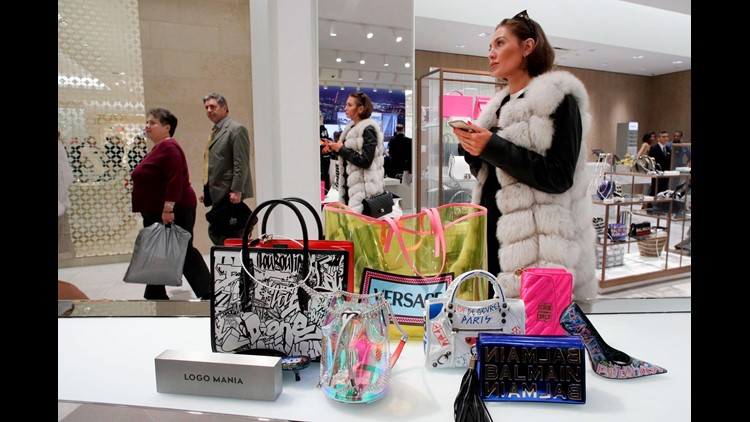The notoriously boom-or-bust fashion industry is turning to a surprising source to woo shoppers: secondhand clothes and handbags.
The resale clothing marketplace in the United States is exploding. Over the past three years, the secondhand clothing market has grown 21 times faster than the overall industry, according to a GlobalData Retail research report prepared by resale site ThredUp. The resale clothing industry is expected to nearly double from $28 billion today to $51 billion by 2023.
Neiman Marcus, H&M and online luxury site Farfetch have all recently entered the resale industry to adapt to Americans’ love of secondhand heels, handbags and dresses. They are looking for younger, environmentally conscious and aspirational luxury shoppers who want bargain prices on premium brands.
In April, Neiman Marcus took a minority stake in Fashionphile, a resale site that hawks pre-owned luxury handbags and accessories for up to 80% below their original price. In the future, shoppers will be able to drop off their used shoes and bags at Neiman Marcus stores to ship back to Fashionphile.
Neiman Marcus invested in Fashionphile to achieve “long-term and sustainable growth,” Neiman CEO Geoffroy van Raemdonck said in a statement. He believes the partnership will help “introduce Neiman Marcus to younger and aspirational shoppers.”
Big retailers are responding to the rapid growth of online resale fashion startups, such as ThredUp, The RealReal, Poshmark, Fashionphile and others. Resale companies compete directly with high-end retailers, department stores and fast-fashion for customers and they threaten luxury brands’ pricing power and exclusivity.
Resale sites have “effectively built small communities,” pairing sellers looking to unload their old clothes for cash with buyers eager to score deals, Cowen analyst Oliver Chen said in a recent report to clients.
‘Conscious consumer’
Millennials and Gen Z shoppers are buoying the resale clothing industry. More than one in three Gen Z shoppers will buy secondhand clothes this year, compared to just 19% of Boomers, according to GlobalData research.
Environmental and economic conditions are converging to push younger shoppers to secondary markets.
In the last 15 years, clothing production around the world has doubled, even as the average number of times people wear their outfits has fallen, according to the conservation organization Ellen MacArthur Foundation. The global fashion industry is on track to account for a quarter of the world’s annual carbon budget by 2050, the group estimates.
However, waste in the clothing and textile industries is becoming a top concern for younger shoppers. Nearly three-quarters of 18 to 29-year-old shoppers say they prefer to buy from sustainability-conscious brands, according to GlobalData.
“This was really a sustainability angle,” Farfetch CEO Jose Neves told analysts earlier this month of his company’s move into the resale market.
Resale platforms offer shoppers a way to recycle their old clothes and buy new styles in environmentally friendly ways.
Hunt for bargains
Resale clothing sites also appeal to younger shoppers who want to dress to fleeting fashion trends and cycle through different outfits, analysts say.
ThredUp, for example, says it adds 15,000 new items to its site every day as more sellers put up their old styles online.
Resale fits into the broader pattern of explosive growth in discount retail, too. Resale players offer prices 30% to 90% below traditional retailers, according to Chen.
TJMaxx, Marshalls and other discount chains are growing, while department stores like Macy’s, Saks and Nordstrom have opened discount arms such as Macy’s Backstage and Saks Off Fifth.
Despite a stronger economy in recent years, Americans across age groups and income levels are looking for bargains. Eighty-nine percent of all US consumers say they shop at discount retailers, according to a survey last year by the National Retail Federation, an industry trade group. The rate is even higher among Millennials and Gen Z shoppers.
Younger shoppers, often carrying high levels of student debt, are “more cost conscious,” said Ari Ginsberg, professor of entrepreneurship and management at NYU’s Stern School of Business. The combination of top brands at affordable prices on resale and rental sites is “particularly potent for Millennials and Gen Z,” he added.
‘Pre-loved pieces’
Traditional retailers can’t ignore the growth in the resale industry, so they’re finding ways to play in it.
Neiman Marcus says that more than half of its customers already use the resale market. It wants to keep those customers when they shop for secondhand goods while branching out to reach Fashionphile’s younger audience.
At select Neiman Marcus stores, customers will be able to receive a price for their items from Fashionphile on the spot and get cash back. Neiman hopes those shoppers will then go spend that extra cash on new products in its stores.
Other retailers are trying out the resale market, too. H&M said in April that it will test a resale program in Sweden for “pre-loved pieces” from its & Other Stories brand.
“We’re exploring different ideas on how our long-lasting designs can find their way to new owners,” said Sanna Lindberg, who oversees the brand at H&M.
Online luxury retailer Farfetch began piloting Farfetch Second Life in May, a buyback program that enables customers to trade their designer handbags in for credit on future Fartetch purchases.
Expect to see more retailers make acquisitions, strike partnerships and test models to enter the resale industry, analysts predict.
“This is an old story of when you see industry disruption,” said Ginsberg. “If you don’t develop those capabilities or go into those markets, you might be extinct pretty soon.”



